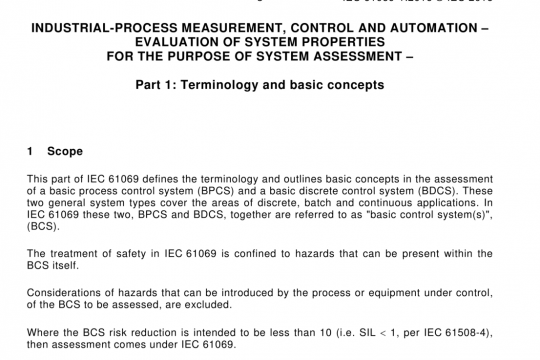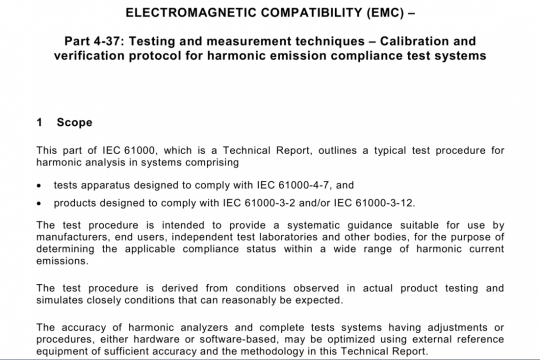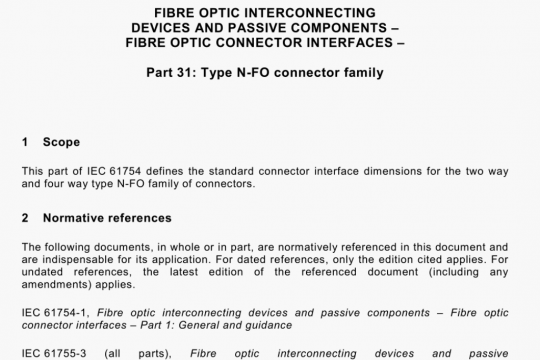BS IEC 62765-2 pdf free download
BS IEC 62765-2 pdf free download.Nuclear powers plants – Instrumentation and control important to safety – Management of ageing of sensors and transmitters Part 2: Temperature sensors.
5 Technical background
5.1 General
IAEA SSR-2/1 describes the requirements of ageing management in the design for safe operation over a lifetime. It is also necessary that a design margin be provided to take account of the ageing mechanism, neutron embrittlement, and wear out, as well as the potential for ageing degradation. SSR-212 also requires an effective ageing management program over the operating lifetime of the plant. Subclauses 6.135 to 6.152 of SSG-39:2016 recommend design consideration for ageing management specific to l&C systems to meet the requirements of SSR-211.
The baseline of requirements of ageing management is to understand and identify the ageing phenomena, which cover the ageing mechanism, causes and potential effects of temperature sensors. Annex A summarises various kinds of tests for performance verification in order to identify a degradation in lifetime and to assess an ageing mechanism. IEC 62342 guides the general aspect of ageing management of instruments including temperature sensors, whereas IEC 60737 and others listed in Annex B cover characteristics and test methods of temperature sensors. Existing IAEA and IEC standards for ageing management standards are summarised in Annex B.
Performance tests in Annex A are important because they can detect ageing effects. Acceptance criteria for tests of temperature sensors are a critical element of an ageing management program (AMP) and they should be understood to identify the ageing effects, to evaluate the ageing problem, and to take a corrective action. The specified temperature tolerances of temperature sensors used as a basis for acceptance criteria for calibration tests are summarised in Annex C. Key steps and an example of AMP sheet are shown in Annex D.
5.2 Type of the sensors in IEC standards
5.2.1 General
TCs and RTDs are both used for the temperature measurement of fluid, steam, or gas in the process of NPPs. The choice of TC versus RTD depends on the application and requirements for accuracy, response time, repeatability, linearity, and other factors.
The difference of accuracy or tolerance between PTs and temperature sensors is as follows:
• Expression of accuracy of PTs: percentile of full span, the same within a full span.
• Expression of accuracy of temperature sensors: not the same within a full span, but constant within a specific temperature range and linearly dependent on measuring temperature beyond the range.
5.2.2 RTDs in IEC standards
An RTD consists of a wired coil or deposited film of pure metal, commonly platinum, whose resistance changes with temperature. IEC 60737 describes the requirements of qualification tests and other design type tests of the temperature sensors in NPPs. IEC 60751 specifies temperature tolerances for each class of RTD, temperature/resistance relationship (i.e. a reference calibration diagram), and acceptance criteria for type tests and routine tests. IEC 60751 has been used widely as an industrial RTD standard. IEC 62397 specifies environmental qualification and other requirements for RTDs in NPPs.
5.3 Interface between the sensors and process in IEC standards
5.3.1 Thermowell
A temperature sensor, RTD and thermocouple, can be used either in direct contact with the process to be measured (bare) or inside a thermowell, which can protect the sensors from the environmental conditions.
Subclause B.2.1 and Clause C.6 of IEC 62342:2007 discuss ageing effects and a performance degradation of response time due to interface problem of thermowell.BS IEC 62765-2 pdf download.




